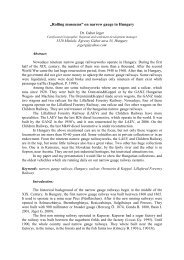'Representing Difficult Pasts within Complex Presents ... - T2M
'Representing Difficult Pasts within Complex Presents ... - T2M
'Representing Difficult Pasts within Complex Presents ... - T2M
You also want an ePaper? Increase the reach of your titles
YUMPU automatically turns print PDFs into web optimized ePapers that Google loves.
One exhibit of interest was an installation piece created by Chris Teale that consisted of a<br />
blacked-out large glass cabinet, with a single peephole. The cabinet had a sign at the front – dedicated to<br />
the memory of ‘all black, coloured and Indian soldiers who served their country in two world wars’.<br />
Inside the installation were poppies, one for every soldier who died. Also inside the cabinet was what<br />
these SAAF servicemen were given when they retired from service - five pounds, a citizen’s suit in khaki,<br />
and a bicycle, another somewhat ironic form of transport. Teale’s conceptual approach was that, through<br />
having to peer into the cabinet, what was perhaps invisible information became noticeable; consequently<br />
he claimed he drew attention to this particular aspect of SAAF history.<br />
Stasis and Change - Museum Africa<br />
Museum Africa in Johannesburg was undergoing reassessment of its collection under its new<br />
director, Ali Hlongwane. There were a few items and exhibitions of note for this discussion. One exhibit<br />
in the geology exhibition section had a construction that allowed children to stand on a replica of the<br />
moon’s surface with their head through a hole in place of the face of a figure in a moon suit - a little like<br />
old-fashioned seaside holiday pictures - to have a photograph taken as if going to the moon. Although<br />
maybe stretching (both metaphorically and physically) the point a little here, perhaps a museum of<br />
transport and mobility could include issues like trips to the moon and space travel 24 ? This exhibit is<br />
apparently very popular with children, and such interactive factors could be borne in mind when creating<br />
a museum of transport and mobility, also serving to provide the memento of a photograph.<br />
18<br />
Museum Africa also had an exhibition on Gandhi’s visit to South Africa, where he is known for<br />
having had a dispute on a train in South Africa in 1893 concerning segregation ,and was thrown off in<br />
Pietermaritzburg. The museum also contains the famous Bensusan museum of photography, an excellent<br />
resource for early photographs of transport in South Africa. One of the photographs blown up to a large<br />
size in the main hall of Museum Africa portrayed the square in front of the museum, filled with ox carts.<br />
Migrancy and Labour - Lwandle Migrant Labourers’ Museum, Workers’ Museum, and<br />
Outeniqua Transport Museum Trains<br />
Migrant Labour museums also relate to issues of South African mobility and transport. Migrant<br />
labour needed the use of an intensive network of trains to transport people across South Africa, as well as<br />
goods produced by factories and mines (Pirie 1993, 1997). As mentioned earlier, labourers lived in<br />
cramped conditions, many beds to one room, and could return home only once a year to their families, for<br />
24 This might not seem too ridiculous, given that South African multimillionaire entrepreneur Mark<br />
Shuttleworth recently went to the moon.




